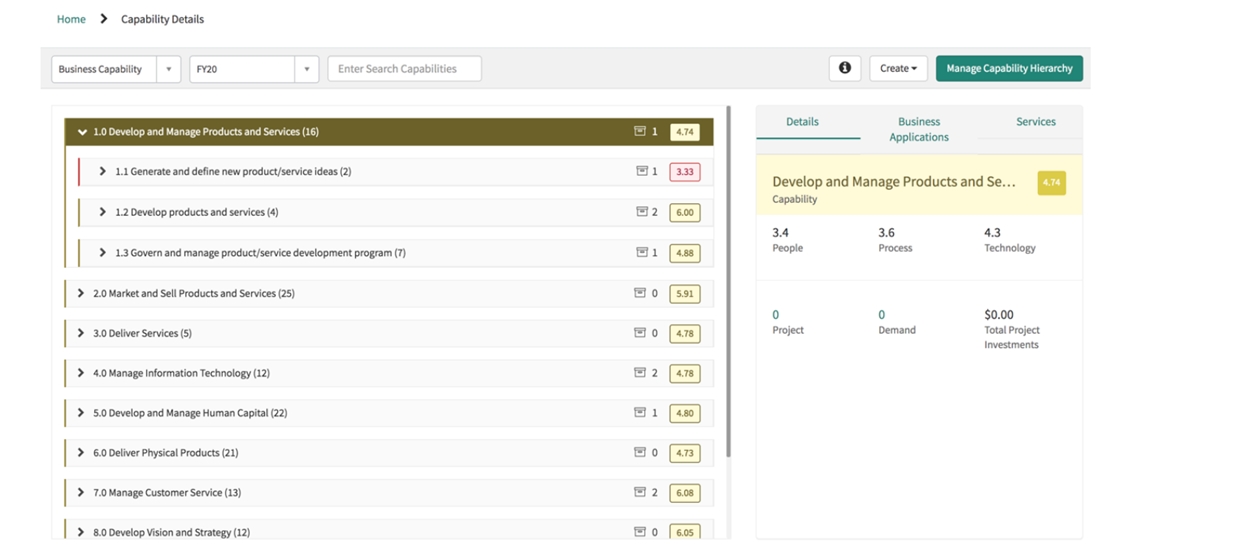Project portfolio management has evolved considerably as a result of the digital transformation. The use of PPM solutions is no longer limited to IT management, but is increasingly being extended to business units: in other words, to the dovetailing of strategy and operational project implementation. In order for this to succeed, a profound examination of the business capabilities of a company is required.
Read about it in this blog post:
- Why enterprise architects work with strategic project portfolio management (SPM) solutions
- What business capabilities are and how they can be used to close the gap between strategy and implementation.
- How business capabilities can be analysed, documented and harnessed with ServiceNow SPM
- The benefits of business capabilities in strategic project portfolio management
Why do Enterprise Architects work with strategic project portfolio management solutions?
Enterprise architects are important intermediaries between the business and IT sides and are responsible for the development of the enterprise architecture. They are responsible for optimising historically grown IT infrastructures and ensuring that, in combination with new technologies or through these alone, the strategic goals of a company can be achieved.
Strategic project portfolio management solutions are an important working tool for enterprise architects in several respects:
- SPM ideally encompasses the entire project work of a company and offers conclusions about all technological developments.
- SPM maps the strategy of a company and thus completes the data situation that enterprise architects need to be able to fulfil their work mandate.
- with its integrated application portfolio management, SPM offers a comprehensive tool suite for making well-founded decisions on the deployment and further development of business applications, based on technical, financial and business strategy criteria.
What are business capabilities and how do they enable us to close the gap between strategy and implementation?
A strategy is only as strong as its implementation. This insight is not new, and yet up to 80% of companies usually fail to realise their objectives. This is sometimes also due to the fact that in corporate practice an essential building block for merging strategy and implementation is not yet sufficiently taken into account. Although many companies succeed in defining their processes, even in good alignment with strategic goals, a discussion of the necessary business capabilities rarely takes place. This is exactly what is needed so that business and IT are optimally aligned and the digital transformation of a company receives tailwind.

Business capabilities are cross-departmental competencies of a company that are jointly created by people, processes and technologies. An example: In an insurance company, there is the business capability "contract cancellation". This primarily involves customer service, which receives and processes the cancellation. Other important process partners are Finance, Sales and Marketing. Finance takes care of customer billing, Sales tries to counteract the termination in selected cases through customer talks, and Marketing can often still carry out campaigns after the termination in order to reactivate the contractual relationship. If the data flows and systems used are mapped around a business capability, it is easy to see where there are structural and technological obstacles to fully meeting the business requirement.
How can business capabilities be analysed, documented and made usable with ServiceNow SPM?

With ServiceNow SPM you can create business capability maps, whereby individual business capabilities can be fully mapped and evaluated. Identify in a structured and objective way where your company's strengths and weaknesses actually are:
- Is there a need for improvement at the staff level (lack of staff, lack of training)?
- Are there undefined process steps that need to be clarified and communicated?
- Are only fractions of an existing solution being used, even though the business capability would benefit from the greater functional scope of the software?
- Are there technological risks for the fulfilment of the business capability (end of support of a software, cloud migration)?

What are the benefits of business capabilities in strategic project portfolio management?
The professional examination of business capabilities has enormous potential to accelerate the digital transformation of companies and to positively influence the achievement of strategic goals:
- Business capabilities create transparency and serve as quality control: Do the current or planned projects promote those business capabilities that urgently need to be further developed?
- The analysis of business capabilities provides important strategic impulses and new targeted project ideas: An awareness of one's own strengths and weaknesses can bring new products and services to life!
- Business capabilities expose company-wide technological risks and process breaks
- Business and IT have a common language through business capabilities, which facilitates the development of suitable solutions.
Capture Practice Tip
Use the potential of strategic project portfolio management and do not shy away from considering the level of business capabilities. Because this is precisely what makes the management of complex interrelationships concretely feasible!